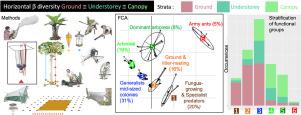Basic and Applied Ecology ( IF 3.0 ) Pub Date : 2021-06-19 , DOI: 10.1016/j.baae.2021.06.007 Maurice Leponce , Bruno Corbara , Jacques H.C. Delabie , Jérôme Orivel , Henri-Pierre Aberlenc , Johannes Bail , Hector Barrios , Ricardo I. Campos , Ivan Cardoso do Nascimento , Arthur Compin , Raphaël K. Didham , Andreas Floren , Enrique Medianero , Sérvio P. Ribeiro , Yves Roisin , Juergen Schmidl , Alexey K. Tishechkin , Neville N. Winchester , Yves Basset , Alain Dejean

|
Ants are a major ecological group in tropical rainforests. Few studies in the Neotropics have documented the distribution of ants from the ground to the canopy, and none have included the understorey. A previous analysis of an intensive arthropod study in Panama, involving 11 sampling methods, showed that the factors influencing ant β diversity (i.e., changes in assemblage composition) were, in decreasing order of importance, the vertical (height), temporal (season), and horizontal (geographic distance) dimensions. In the present study, we went one step further and aimed (1) to identify the best sampling methods to study the entire ant assemblage across the three strata, (2) to test if all strata show a similar horizontal β diversity and (3) to analyze the functional structure of the entire ant assemblage. We identified 405 ant species from 11 subfamilies and 68 genera. Slightly more species were sampled in the canopy than on the ground; they belonged to distinct sub-assemblages. The understorey fauna was mainly a mixture of species found in the other two strata. The horizontal β diversity between sites was similar for the three strata. About half of the ant species foraged in two (29%) or three (25%) strata. A single method, aerial flight interception traps placed alongside tree trunks, acting as arboreal pitfall traps, collected half of the species and reflected the vertical stratification. Using the functional traits approach, we observed that generalist species with mid-sized colonies were by far the most numerous (31%), followed by ground- or litter-dwelling species, either specialists (20%), or generalists (16%), and arboreal species, either generalists (19%) or territorially dominant (8%), and finally army ants (5%). Our results reinforce the idea that a proper understanding of the functioning of ant assemblages requires the inclusion of arboreal ants in survey programs.
中文翻译:

巴拿马低地雨林中整个蚂蚁组合的空间和功能结构
蚂蚁是热带雨林中的一个主要生态群体。新热带地区的研究很少记录蚂蚁从地面到树冠的分布情况,而且没有一项研究包括下层。先前对巴拿马的一项密集节肢动物研究(涉及 11 种采样方法)的分析表明,影响蚂蚁 β 多样性(即组合组成的变化)的因素按重要性降序为垂直(高度)、时间(季节) ,和水平(地理距离)尺寸。在本研究中,我们更进一步,目的是 (1) 确定研究三个层的整个蚂蚁组合的最佳采样方法,(2) 测试是否所有层都显示出相似的水平 β 多样性和 (3)分析整个蚂蚁组合的功能结构。我们确定了来自 11 个亚科和 68 个属的 405 种蚂蚁。在树冠中采样的物种比在地面上采样的要多一些;它们属于不同的子组合。下层动物群主要是在其他两个地层中发现的物种的混合物。三个地层的站点之间的水平β多样性相似。大约一半的蚂蚁物种在两个 (29%) 或三个 (25%) 地层中觅食。一种单一的方法,即放置在树干旁边的空中飞行拦截陷阱,充当树上陷阱陷阱,收集了一半的物种并反映了垂直分层。使用功能特征方法,我们观察到具有中等规模群体的通才物种数量最多(31%),其次是地面或垃圾栖息物种,专家(20%)或通才(16%)和树栖物种,通才 (19%) 或领土主导 (8%),最后是军蚁 (5%)。我们的结果强化了这样一种观点,即正确理解蚂蚁组合的功能需要将树栖蚂蚁纳入调查计划。









































 京公网安备 11010802027423号
京公网安备 11010802027423号